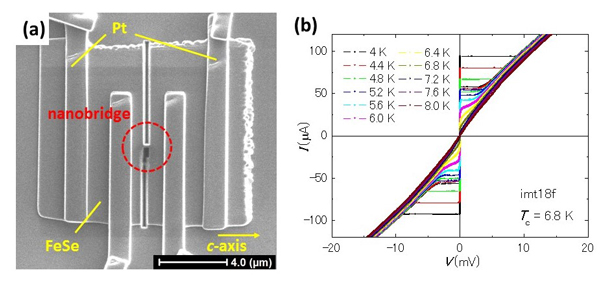PC8-8
Focused Ion Beam Microfabrication of Single-crystal Nanobridge Toward FeTe1-xSex-based Josephson Device
Dec.3 15:15-15:30 (Tokyo Time)
Dept. of Physics and Mathematics. Aoyama Gakuin Univ., Sagamihara 252-5258, Japan1
Dept. of Applied Physics, Univ. of Tokyo, Tokyo 113-8656, Japan2
Iron chalcogenide superconductors have attracted much attention because some novel phenomena associated with nematic phase [1] and topological superconductivity [2] were discovered, in spite of the simple crystal structure composed of Fe(Te,Se) layers. Recently, we reported the achievement of a depairing current limit in the c-axis narrow bridges of Fe(Te,Se) single crystals fabricated by the focused ion beam (FIB) etching [3]. The FIB microfabrication is also useful to prepare the superconducting weak links, which may exhibit the Josephson effects [4].
Here, we present a study on the transport properties of the superconducting Fe(Te,Se) nanobridges with a cross section area smaller than 0.1 µm2. We proposed a method to obtain the single-crystal nanobridges based on the pickup of a small lamella for transmission electron microscopy (TEM) observation and the FIB deposition of Pt contact electrodes. This method favors in reducing the cross section area of narrow bridges, since it can avoid a mechanical breakdown in cooling processes down to cryogenic temperatures. The reduction of cross section area is crucially important to realize the Josephson effects. As shown in Fig. (a), we succeeded in fabricating a nanobridge with the cross section area of 0.06 µm2 (width is ~150 nm, height is ~400 nm), which was comparable to that of the FeTe0.5Se0.5 nanobridges made from thin films [4]. Figure (b) shows the typical current-voltage characteristics of the c-axis nanobridge of FeSe (Tc = 6.8 K). The hysteretic behavior observed below 6 K was due to the Joule heating, as previously reported [3]. We found that the obtained critical current Ic was roughly two orders of magnitude smaller than that for the previous microbridges [3], which is close to requirement for the Josephson effects. This suggests that our method is promising to develop the single-crystal Josephson devices, which are expected to play an important role toward the application of the unique properties in Fe(Te,Se) superconductors.
[1] T. Shibauchi et al., arXiv: 2005.07315 (2020). [2] P. Zhang et al., Science 360, 182 (2018). [3] Y. Sun et al., PRB 101, 134516 (2020). [4] C. H. Wu et al., APL 102, 222602 (2013).
(a) The scanning ion microscopy image of the fabricated nanobridge of FeSe.
(b) Current-voltage characteristics of the nanobridge.
Keywords: Iron chalcogenide superconductors, Nanobridge, FIB, Josephson effect
